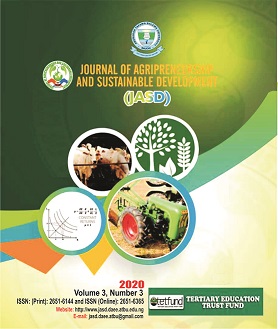UTILIZATION OF GRADED LEVELS OF PEARL MILLET AS DIETARY ENERGY SOURCE BY JAPANESE QUAILS
DOI:
https://doi.org/10.59331/jasd.v3i3.131Keywords:
Diets, Energy, Feed intake, Growing phase, QuailAbstract
The study was carried out to investigate the inclusion levels of pearl millet in the diets of quails (Coturnix coturnix japonica). A total number of 480 day-old quail birds were used in the study. Experimental diets contained 10, 20, 40, 60, 80, and 100% millet. Diets contained 24% CP, 2888 kcal/kg ME and 20% CP, 2778 kcal/kg ME for growing and laying phases, respectively. The experiment lasted for 119 days and data were collected on daily feed intake (DFI), total weight gain, daily water intake, egg weight, hen day egg production, egg quality, and haematological parameters. At growing phase (2-6 weeks), most of the parameters measured were significantly influenced by the dietary levels of millet except initial weight (20.50-21.755g/bird), age and weight at 1st lay, 39-43 days and 6.00-7.00 g, respectively. At the laying phase (6-17 weeks) all the parameters measured showed significant (P<0.001) differences except in DFI (26.70-30.60 g). In carcass characteristics, most of the parameters measured were not significantly (P<0.05) affected by the dietary levels except in live weight which is significantly (P<0.01) different; breast weight and back weight were significantly (P<0.05) different and thigh weight (P<0.001), respectively. The following egg quality parameters; albumen width and albumen weight were highly significantly (P<0.01) different while yolk weight was very highly significantly (P<0.001) different. The haematological indices showed that there were significant (P<0.001) differences among the white blood cell, red blood cell, mean corpuscular volume, and mean corpuscular haemoglobin concentration. It was concluded that pearl millet can be included at 100% levels in diets of Japanese quails without adverse effects on growth performance and hen day egg production. Since carcass yield, haematological parameters and prime cuts were not adversely influenced by the dietary levels of pearl millet, it was therefore, recommended as energy dietary source for Japanese quails.
Downloads

Downloads
Published
How to Cite
Issue
Section
License
Copyright (c) 2022 Journal of Agripreneurship and Sustainable Development

This work is licensed under a Creative Commons Attribution 4.0 International License.






